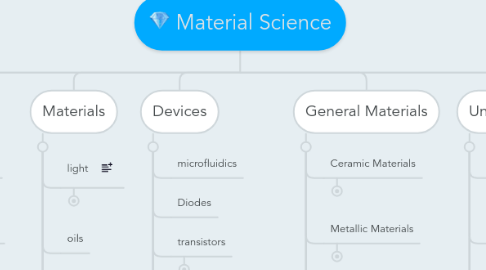
1. Synthesis / Processing / Fabrication / Deposition
1.1. lithography
1.2. Deposition
1.2.1. Sputtering
1.2.2. Epitaxy
1.2.3. Chemical Vapor Deposition
1.2.4. Thermal Oxidation
1.2.5. Evaporation
1.2.6. Casting
1.3. spin coating
1.4. Etching
1.4.1. Pirahna
1.5. doping
2. Properties
2.1. Electrical Properties
2.1.1. conductivity
2.1.2. electron mobility / resisitivity
2.1.3. capacitance
2.1.4. fermi energy
2.1.5. Ohm's Law
2.1.6. Conduction / Valence bands
2.1.7. carrier concentration
2.2. Magnetic properties
2.2.1. diamagnetism
2.2.2. paramagnetism
2.2.3. ferromagnetism
2.2.4. temperature dependance
2.2.5. superconductivity
2.2.6. hysteresis
2.3. bonding
2.3.1. ionic
2.3.2. secondary
2.3.2.1. van der waals
2.3.2.2. dipole
2.3.2.3. hydrogen bonding
2.3.3. metallic
2.3.4. covalent
2.4. Structural Properties
2.4.1. crystal
2.4.1.1. lattice structure
2.4.1.1.1. Unit Cell
2.4.1.1.2. bravais lattice
2.4.1.1.3. symmetry
2.4.1.1.4. van der waals solids
2.4.1.2. twinning
2.4.1.3. grain boundaries
2.4.1.4. defects
2.4.2. atomic
2.4.2.1. table of elements
2.5. Mechanical Properties
2.5.1. failure
2.5.1.1. chemical
2.5.1.1.1. internal
2.5.1.1.2. external
2.5.1.1.3. exposure
2.5.1.2. physical
2.5.1.2.1. crack propagation
2.5.1.2.2. creep
2.5.1.2.3. fatigue
2.5.1.2.4. fracture
2.5.1.2.5. tension
2.5.1.2.6. shear
2.5.1.2.7. impact
2.5.2. deformation
2.5.2.1. stress-strain curves
2.6. Chemical Properties
2.7. Surface Properties
2.8. Thermodynamics
2.8.1. phase diagrams
2.8.1.1. kinetics
2.8.1.2. equilibrium
2.8.1.3. eutectic
2.8.1.4. water
2.8.1.5. critical point
2.8.2. phase stability
2.9. Optical Properties
2.9.1. refraction
2.9.2. reflection
2.9.3. opacity
2.9.4. absorption
2.9.5. luminescence
2.10. Thermal Properties
2.10.1. heat capacity
2.10.2. thermal expansion
2.10.3. thermal conductivity
3. Materials
3.1. light
3.1.1. LEDs
3.1.2. incandescent
3.1.3. halogen
3.2. oils
3.3. waxes
3.4. adhesives
3.4.1. tapes
3.4.2. glues
3.5. sealants
3.6. Inks
3.7. clay
3.8. coatings
3.9. films
4. Devices
4.1. microfluidics
4.2. Diodes
4.3. transistors
4.3.1. MOSFETS
4.4. computer hardware
4.5. Solar Cells
4.6. photo voltaics
4.7. sensors
4.7.1. piezoelectrics
4.8. dielectrics
4.9. thermoelectrics
4.10. batteries
5. General Materials
5.1. Ceramic Materials
5.1.1. glass
5.1.2. cements
5.2. Metallic Materials
5.2.1. alloys
5.2.1.1. ferrous alloys
5.2.2. steel
5.3. Polymer Materials
5.3.1. Plastics
5.3.1.1. types
5.3.1.1.1. thermosets
5.3.1.1.2. thermoplastics
5.3.1.1.3. elastomers
5.3.1.2. synthesis techniques
5.3.1.2.1. chain growth
5.3.1.2.2. step growth
5.3.1.2.3. emulsion
5.3.1.2.4. copolymerization
5.3.1.2.5. crosslinks
5.3.2. hydrogels
5.3.2.1. Amino Acids
5.3.3. Properties
5.3.3.1. thermodynamics
5.3.3.1.1. entropy
5.3.3.1.2. mixing
5.3.3.1.3. enthalpy
5.3.3.1.4. phase behavior
5.3.3.2. elasticity
5.3.3.2.1. honey dashpot model
5.3.3.2.2. viscosity
5.3.3.2.3. Modulus
5.3.3.2.4. stress / strain
5.3.3.3. solvents
5.3.3.3.1. plasticizers
5.3.3.4. light properties
5.3.3.4.1. refractive index
5.3.3.4.2. Zimm Plot
5.3.3.4.3. Bragg's Law
5.3.3.4.4. Scattering
5.3.3.5. physical
5.3.3.5.1. molecular weight
5.3.4. Additives
5.3.4.1. filler
5.3.4.2. plasticizers
5.3.4.3. stabilizers
5.3.4.4. colorants
5.3.4.5. flame retardants
5.4. Composite Materials
5.4.1. fibers + epoxy
5.5. colloids
5.5.1. emulsions
5.5.2. foams
5.5.3. aerosols
5.5.4. gels
5.6. semiconductors
6. Uncategorized Materials
6.1. self healing
6.1.1. https://www.youtube.com/watch?v=1i3yoK0C9Ag
6.2. shape memory
6.2.1. alloy
6.2.2. polymer
6.3. nanomaterials
6.3.1. quantum dots
6.3.2. metamaterials
6.3.2.1. negative refraction
6.3.3. nanowires
6.3.4. nanoparticles
6.4. animal mimetics
6.4.1. resilin
6.4.2. silk
6.4.3. collagen mimetic peptides (CMPs)
6.5. graphene
6.5.1. applications
6.5.2. forms
6.5.2.1. buckyballs
6.5.2.2. fullerenes
6.6. biomaterials
6.6.1. biocompatability
6.6.2. controlled release
7. Analysis Techniques
7.1. fluid properties
7.1.1. Rheology
7.1.1.1. viscosity
7.1.1.2. Reynolds number
7.1.2. transport phenomenon
7.2. atomic structure / shape
7.2.1. TEM
7.2.2. diffraction
7.2.2.1. X-ray diffraction
7.2.2.1.1. single crystal
7.2.2.1.2. powder diffraction
7.2.2.2. laue back-reflection
7.2.2.3. electron diffraction
7.2.2.4. neutron diffraction
7.2.3. IR Spectroscopy
7.2.4. NMR
7.2.5. SEM
7.2.6. crystallography
7.2.7. circular dicroism
7.2.7.1. secondary structure
7.3. chemical composition
7.3.1. Chromatography
7.3.2. raman spectroscopy
7.3.3. tunneling
7.3.4. SQUID
7.3.5. Mass Spectrometry
7.4. mechanical properties
7.4.1. compression
7.4.1.1. spreadability
7.4.1.2. hardness
7.4.2. bending
7.4.2.1. flexural
7.4.2.2. folding
7.4.2.3. peel
7.4.3. fatigue testing
7.4.3.1. burst
7.4.3.2. chewiness
7.4.3.3. double shear
7.4.3.4. friction resist
7.4.3.5. puncture
7.4.3.6. rupture
7.4.3.7. slip
7.4.3.8. tensile
7.4.3.9. texture
7.4.4. elasticity
7.4.4.1. resilliance
7.4.4.2. ductility
7.5. Surfaces
7.5.1. AFM
